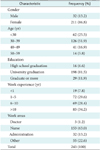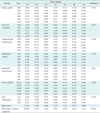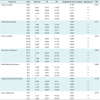1. Hung SY, Hung WH, Tsai CA, Jiang SC. Critical factors of hospital adoption on CRM system: organizational and information system perspectives. Decis Support Syst. 2010; 48(4):592–603.

3. Cho DY, Kim YJ. The study on characteristics of university medical center users. Rev Bus Econ. 2009; 22(5):2399–2420.
4. Lee SH. Diversification of hospital services in Korea [dissertation]. Seoul, Korea: Yonsei University;1990.
7. Ngai EW. Customer relationship management research (1992-2002): an academic literature review and classification. Mark Intell Plan. 2005; 23(6):582–605.
8. Bauer HH, Grether M, Leach M. Building customer relations over the Internet. Ind Mark Manag. 2002; 31(2):155–163.

9. Reichheld FF, Sasser WE Jr. Zero defections: quality comes to services. Harv Bus Rev. 1990; 68(5):105–111.
10. Beak HS. Research and study on performance analysis of hospital CRM system and its improvement [dissertation]. Seoul, Korea: Yonsei University;2008.
11. Almunawar MN, Anshari M. Improving customer service in healthcare with CRM 2.0. GSTF J Bus Rev. 2011; 1(2):7.
12. DeLone WH, McLean ER. Information systems success: the quest for the dependent variable. Inf Syst Res. 1992; 3(1):60–95.

13. DeLone WH, McLean ER. The DeLone and McLean model of information system success: a ten-year update. J Manag Inf Syst. 2003; 19(4):9–30.
14. Pitt LF, Watson RT, Kavan CB. Service quality: a measure of information systems effectiveness. MIS Q. 1995; 19(2):173–187.

15. Seddon PB. A respecification and extension of the DeLone and McLean model of IS success. Inf Syst Res. 1997; 8(3):240–253.

16. Myers BL, Kappelman LA, Prybutok VR. A comprehensive model for assessing the quality and productivity of the information systems function: toward a contingency theory for information systems assessment. Inf Resour Manag J. 1997; 10(1):6–26.

17. Yusof MM, Paul RJ, Stergioulas LK. Towards a framework for health information systems evaluation. In : Proceedings of the 39th Annual Hawaii International Conference on System Sciences; 2006 Jan 4-7; Kauai, HI.
18. Seddon PB, Kiew MY. A partial test and development of the DeLone and McLean's model of IS success. Australas J Inf Syst. 1996; 4(1):90–109.
19. Rainer RK, Watson HJ. The keys to executive information systems success. J Manag Inf Syst. 1995; 12(2):83–98.
20. Davis FD. Perceived usefulness, perceived ease of use, and user acceptance of information technology. MIS Q. 1989; 13(3):319–340.

21. Agarwal R, Karahanna E. Time flies when you're having fun: cognitive absorption and beliefs about information technology usage. MIS Q. 2000; 24(4):665–694.

22. Halawi LA, McCarthy RV, Aronson JE. An empirical investigation of knowledge management systems' success. J Comp Inf Syst. 2008; 48(2):121–135.
23. Hsieh JJ, Wang W. Explaining employees' extended use of complex information systems. Eur J Inf Syst. 2007; 16:216–227.

24. Kim J, Chae YM, Kim S, Ho SH, Kim HH, Park CB. A study on user satisfaction regarding the Clinical Decision Support System (CDSS) for medication. Healthc Inform Res. 2012; 18(1):35–43.

25. Lee SH, Jung JI, Lee JR. An empirical study on customer satisfaction of health examination center. J Global Acad Mark Sci. 2000; 6:211–231.
26. Iivari J. An empirical test of the DeLone-McLean model of information system success. ACM SIGMIS Database. 2005; 36(2):8–27.

27. Nunnally JC. Psychometric theory. New York (NY): McGraw-Hill;1978.
28. Byrne BM. Structural equation modeling with AMOS: basic concepts, applications, and programming. 2nd ed. New York (NY): Routledge;2010.
29. Hair JF, Black WC, Babin BJ, Anderson RE. Multivariate data analysis. 7th ed. Upper Saddle River (NJ): Prentice Hall;2010.




 PDF
PDF ePub
ePub Citation
Citation Print
Print












 XML Download
XML Download